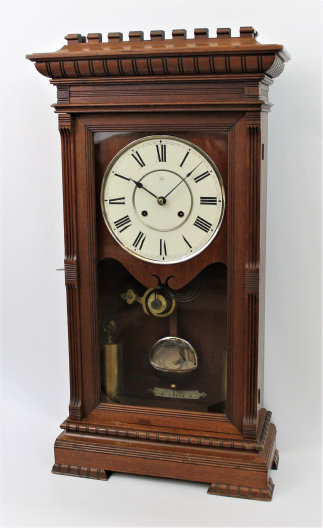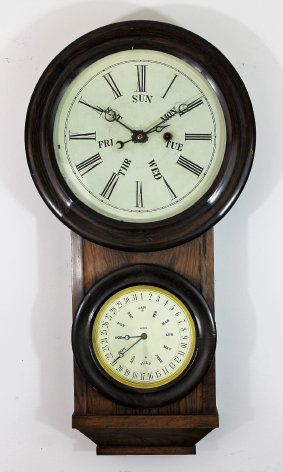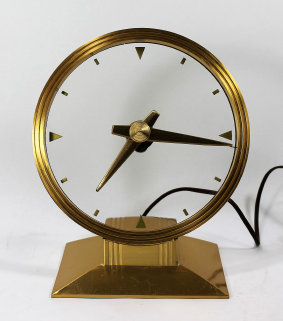

348. $625
L.F. & W.W. Carter “Round Drop Wall Clock”, 1863-1868. This is the smallest version of
this model, at 26 inches in length with a 9-inch time dial (see Miller and Miller, page 62, or Ly, Calendar Clocks, page 40); it is
sometimes referred to as the “miniature” model. The rosewood veneer is complete but you can see the sun bleaching that has occurred
by looking at the interior photo. The case is very clean and you can see the rosewood graining on the bezels quite clearly. Upper dial is painted, with some chipping, the lower dial recently repainted. Both glasses are old but the upper glass has new
putty. Old hands on top, bottom calendar hands look new. The label is suffering badly; we will include some pieces salvaged
from the bottom of the case, and your assignment will be to place plastic shielding over the label to protect it from further losses. The 8-day spring-driven clock is running strongly and the calendar hands are advancing. We have not sold a 26-inch model in
some time and they appear to be the least common of the Carter calendar wall clocks. Two recent sales in the Antique Clocks
Price Guide: $850 in 2011 at Harris and $1000 in 2010 at Schmitt’s. $750-$1000.

349. $1200
Seth Thomas “Garfield”, ca. 1883. “When it rains, it pours” and we have two Garfields in this
auction, not having had one since 2015. This one is also in walnut, the case in cleaner condition; note that 4 small trim pieces
are missing off the top of the case at the back; their loss is not noticeable unless you look (now you will). The trim is nickel
but the weights are brass. Nice shiny damascened pendulum bob and nickel beat scale. The dial was recently repainted;
the hands correct, the glass original. The proper signed Seth Thomas movement is running and striking appropriately on a cathedral
gong. No label and no date on the back. $1200-$1500.
347. $1250
L.F. & W.W. Carter “Extra Eight Day Lever Timepiece”, 1863-1868. Also known as the “Lewis
Calendar No. 6”, this rare double-dial wall calendar from Luther and William is in excellent shape for its 150 years. The bezels
are thick with polish and what-have-you and show some scuff marks and dings, but some rosewood graining still shows through. The very dark trim pieces top, bottom, and sides certainly look original. The case sides are rosewood veneer. It’s not
a large clock, only 29 inches from tip to tip. The 6-inch time dial must be original, the calendar dial presumably repainted. Both glasses appear to be original. The calendar hands are correct, the time hands replaced I think. Inside is a Hubbell-signed
8-day lever movement that is running and keeping time, a Lewis calendar with an excellent green label “Manufactured by the Inventor”,
and a brilliant blue label stating that the clock was made for “Vessels or Private Houses” by the Carters, “Patent Applied for”. The calendar hands are advancing. Some pencil notations on the back, one as early as 1877. Only one example in the Antique
Clocks Price Guide, from 2006, sold for $1600 at Schmitt’s; it had replaced trim. $1250-$2500.


350. $175
Ansonia Iron Front, 1850-1854. The label inside, behind a plastic cover, says Ansonia Clock
Co. and the 8-day brass lyre movement is signed Terry & Andrews; Terry & Andrews turned into Ansonia under Anson Phelps in
1850. The heavy case is 14 inches high, decorated extensively with mother-of-pearl (MOP), hand-painted flowers and gold flourishes. I see only one missing piece of MOP, below the dial on the left. MOP can be purchased at art supply stores. The dial pan
is probably original, repainted I suspect, but the dial bezel and glass have been replaced. There is a button lock on the left. The lower bezel is original, the glass old but replaced. The clock is running strongly and looking good. $175-$250.
346. $1800
L.F. & W.W. Carter “Round Drop Wall Clock”, 1863-1868. The Carters appear to have made
this clock in various sizes; Miller and Miller (Survey of American Clocks, Calendar Clocks, 1972) show three sizes, from 43 inches
to 57 inches in length. This clock measures 48 inches in length, with a 12.5-inch time dial and a 10-inch calendar dial. Welch, Spring & Co. marketed a similar clock 53 inches in length. The case is rosewood and is in excellent condition, with
only slight wear to the wood bezel on the time dial. All three glasses are old, the lower glass looks original, despite being
in outstanding shape; note the small Union shield at the bottom. I’m guessing the time dial was repainted, the calendar dial
may be original, with some chipping. The hands are period and appropriate but hard to know if original; the pendulum bob and
stick look original. All three door locks work and there is a key. Good labels inside. The 8-day, weight-driven,
time-only upside-down movement was made by Welch, has rolling pinions and retaining power, and shows the day of the week on the time
dial; the Lewis Y calendar mechanism was made by Elias Burwell and shows the date and month. The movement is running nicely
and the calendar is advancing. I’m not sure the weights are correct, as they would appear to be from a triple decker clock. This is one of three clocks that came from a collector of quality Carter calendar clocks. I can find no recent sales in the
Antique Clocks Price Guide for a similar model; we estimate $2000-$3000.


351. $25
Haddon Golden Vision, 1957. Haddon mystery clocks look very much like the more common
Jefferson Golden Hour clocks, and both companies were in Chicago, IL. Although both are based on patents by Leendert Prins,
the Haddon clock uses a wire connection from the minute hand tip to a gear ring in the bezel to move the hand, and the geared-down
hour hand, around the dial. Like the Jefferson clocks, the motor is in the base and rotates a gear ring in the bezel. While the dial is vertical in Jefferson clocks, most (but not all) Golden Visions, including this one, have the dial tilted back by
about 10° for easier viewing. The clock also is lit from behind, and the light control is twist knob at the back of the clock. The light shines out an opening, ideally onto a near wall to provide backlighting for the dial. This clock is running and keeping
time; it lacks the bottom cover plate over the motor. The gold-tone case is in excellent condition; the hour hand shows some
small scrape marks. $25-$50.
